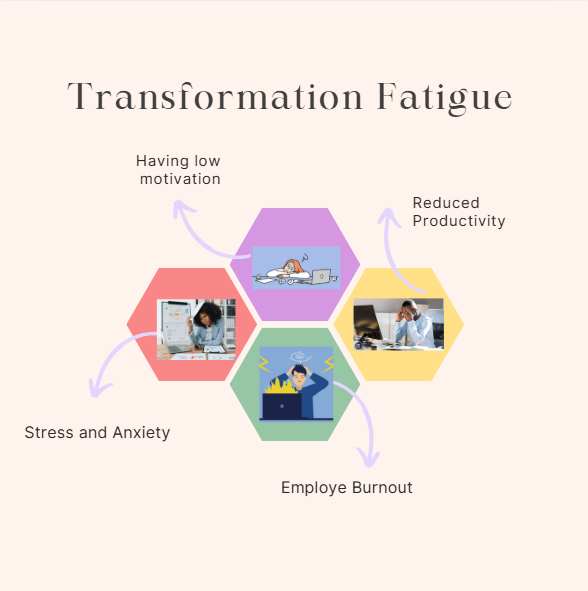Charles Darwin enunciated the evolutionary theory, widely known as the “Survival of the Fittest,” in which he explained that organisms that better adapt to their environment are more likely to survive and reproduce. Although it is a biological concept, it applies not only to organisms but also to organizations in today’s highly competitive business world.
With The CEO Views, we aim to shed light on concepts that not only influence the modern-day business landscape but also determine its future course. From change management to economic factors, we are committed to delivering articles and blogs that cover a wide range of business topics to inform and empower readers.
Organizational Transformation: The Survival of the Fittest
Organizations that are adapted to their business environment are likely to thrive. And, to survive market volatility, they need to embrace transformation as “the only constant.” Initiating and managing change in organizations is similar to remodeling a house. Remodeling a home requires proper planning and causes temporary disruption, which in turn results in a beautifully decorated abode with everything in its place. Driving change in a large organization is similar to this process: a clear vision, careful planning, disrupted operations, and managing the change with visionary and transformational leadership.
However, change implementation in organizations is no less than an uphill battle. Issues of poor management of change and failures of previous transformations often result in resistance to change among the organizational workforce, even among leaders. This is what we call ‘transformation fatigue.’ Overcoming transformation fatigue in large organizations is not a tough nut to crack and requires a strategic approach. Delayed change initiatives and lack of follow-through can further exacerbate resistance, making successful transformation even more challenging.
Before learning the approaches to eliminate this fatigue, let us understand what this fatigue really is and how it affects change initiatives in companies.
Transformation Fatigue: A Change Saturation
We refer to transformation fatigue as change saturation, a state of exhaustion and resistance that employees experience when they are burdened with too many change initiatives in a shorter period or have experienced consecutive failures in change implementation. In today’s competitive and ever-evolving business environment, organizations are constantly striving to adapt and improve their operations to fit into the picture. This constant need for adaptation often translates into sequential transformations. This may include, but is not limited to, new technological integrations, restructuring teams, rebuilding the business model, and redefining roles.
While change is crucial to growth and competitiveness, poorly managed changes can cause transformation fatigue. This fatigue is not merely employees’ resistance to change; it is a deep-rooted psychological phenomenon of emotional toll that such a volatile work environment takes on individuals.
How Transformation Fatigue Occurs in Employees?
Employees burdened with a series of changes may experience increased stress and anxiety about the uncertainties of the future, job security, and adaptability to continuous change. Constant change can demotivate employees, making them feel like their efforts are futile. Fatigue and stress can impede employees’ productivity by reducing their cognitive function and making it difficult for them to focus. Repeated failures of past change initiatives could also make employees cynical about their effectiveness. Burnout is another outcome of constant change, which is characterized by depersonalization, emotional exhaustion, and a sense of reduced accomplishment.
Causes Contributing to Transformation Fatigue in Organizations
Several factors contribute to the development of change fatigue in organizations. Let’s have a look at some of the causes of transformation fatigue.
-
Several Changes within a Short Time Period
Implementing multiple changes simultaneously or within a short period of time can overwhelm employees, making them feel exhausted. They might feel like they cannot cope with the pace, and this leads to increased stress and exertion.
-
Insufficient Training and Support for Employees
Employee training and support are crucial while navigating a change. This helps them adapt to new technologies, processes, and roles. However, if an organization doesn’t offer the required training and support for employees to adapt to the new environment, they might feel incapable of adapting to these changes smoothly.
-
Inconsistency in Leadership
The leader’s vision must align with the change initiatives and the support they demand. If leaders are not aligned in their support for change initiatives, employees can become confused and lose trust in their leaders. Such inconsistency in leadership could lead to a transformation failure.
-
Poor Communication and Lack of Transparency
Change management in complex transformation programs can be made easy with efficient and transparent communication between leaders and employees. But if complex changes are poorly communicated, employees can feel uninformed. This uncertainty can fuel anxiety and resistance.
-
Past Change Failures
Previous failures or poorly managed change initiatives can create a sense of skepticism and resistance among employees.
-
Lack of Employee Involvement
Employees may feel unheard when they are not involved in the change process. They might also feel that the change has been imposed upon them without proper information.
-
Prioritizing Technical or Strategic Elements Only
Many organizations focus on the technical and strategic sides of change, overlooking how it affects employees emotionally and psychologically. As a result, employees can become weary and lose the motivation to embrace transformation.
Battling Transformation Fatigue: The Strategic Steps for Change Leaders to Follow
Mitigating transformation fatigue and fostering a sustainable change requires a holistic and human-centric approach. Prioritizing employee well-being and engagement can successfully eliminate transformation fatigue. Below are some key strategies for leaders to foster a sustainable change-
Facilitate Transparent and Effective Communication
Employees must be informed about the reasons for change, potential outcomes, and the implementation timeline. Leaders should be transparent and honest about the challenges and potential risks. They must leverage multiple communication channels to reach all stakeholders, including employees, and open doors to feedback and questions.
Engage Employees Throughout the Change Process
Employees must be engaged in the planning and implementation of change initiatives. By soliciting their ideas, inputs, and concerns, leaders must empower them to take ownership of the change process and contribute to their success.
Invest Heavily in Leadership Development
By equipping leaders with the necessary skills and knowledge, organizations can empower them to effectively lead their teams through change. Investing in leadership can greatly impact the success of transformation.
Provide Comprehensive Training and Support
Training programs equip employees with the skills they need to adapt to new processes and technologies. Offering learning opportunities helps employees feel more confident and capable of navigating transformation.
Address Employee Concerns
Leaders must acknowledge and address employee anxieties and concerns regarding the change. By cultivating a safe and inclusive workplace, they must allow employees to express their feelings and address them with support.
Celebrate Success and Recognize Contributions
Celebrating small wins and recognizing employee contributions can motivate them to perform well. Acknowledging employee efforts and rewarding them along the way makes them feel included.
Track and Evaluate the Change Impacts
Continuously monitoring and evaluating the impacts of change initiatives on employee productivity and well-being helps eliminate any uncertainties in their mind. Using employee feedback, leaders can make improvements in their change processes.
Align Change Initiatives With the Purpose of Employee Well-Being
The opportunity cost of delayed transformation decisions doesn’t appear on balance sheets or whiteboards. Delaying a transformation that your organization badly needs could result in huge financial and operational losses. But to ensure the successful integration of a change into operations, leaders should align their objectives with employee well-being. Employees who are unwilling to adapt to change could delay the entire change process.











